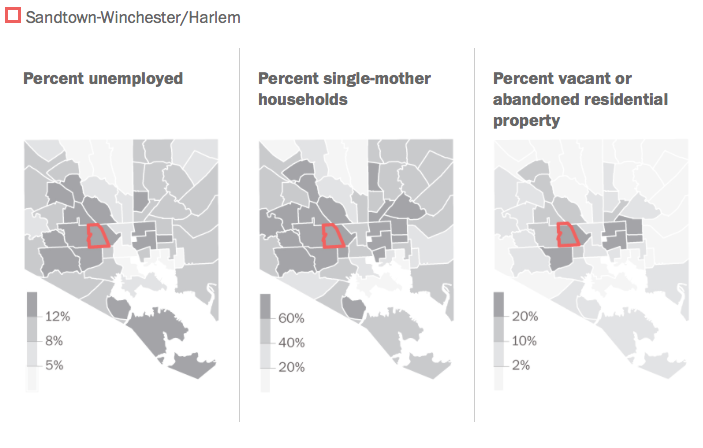As we all locally and globally attempt to come to terms with what is currently happening in our Baltimore neighborhoods, I wanted to point many of you to the media stories that are putting neighborhood context as front and center of that discussion. The Vital Signs indicators have been pointing to key signs of distress not only in Sandtown-Winchester where Freddie Gray lived, but in many other neighborhoods in Baltimore as well.
I hope from the news articles and graphics that are using the community-based indicators to highlight the structural issues that stem from neighborhoods with high unemployment, high vacancy, and low accessibility, everyone locally, nationally and from around the world looking at Baltimore right now can help move the needle on ensuring a better quality of life in every neighborhood.
We will be posting more on Twitter. @bniajfi
Al Jazeera America: Baltimore: The divided city where Freddie Gray lived and died
Baltimore Sun: Sandtown-Winchester ranks well below city average in most health factors
Boston Globe: There are no ‘two Baltimores’
Brookings Institute: The challenges of Baltimore (and the nation) in context
City Lab: There Are Plenty More Baltimores
Justice Policy Institute: The Right Investment? Corrections Spending in Baltimore City
PBS Newshour: Life in Freddie Gray’s childhood neighborhood by the numbers
MSNBC: The Tale of Two Baltimores
New York Times: A Portrait of the Sandtown Neighborhood in Baltimore
Vox: In 2 Baltimore neighborhoods, infant mortality is higher than in the West Bank
Washington Post: Lead levels in Baltimore children
Washington Post: These two maps show the shocking inequality in Baltimore
To learn more about the data behind these stories, visit http://dev.bniajfi.org/2015/04/16/vital-signs-13/
Find community data profiles for all Baltimore’s communities including Sandtown-Winchester/Harlem Park http://dev.bniajfi.org/vital_signs/cprofiles/
– Seema Iyer, PhD



